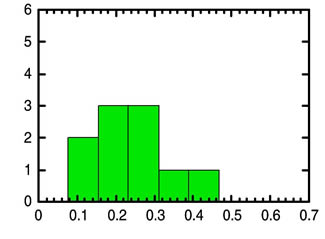Evolutionists generally feel secure even in the face of compelling creationist arguments today because of their utter confidence in the geological time scale. Even if they cannot provide a naturalistic mechanism, they appeal to the "fact of evolution," by which they mean an interpretation of earth history with a succession of different types of plants and animals in a drama spanning hundreds of millions of years.
The Bible, by contrast, paints a radically different picture of our planet's history. In particular, it describes a time when God catastrophically destroyed the earth and essentially all its life. The only consistent way to interpret the geological record in light of this event is to understand that fossil-bearing rocks are the result of a massive global Flood that occurred only a few thousand years ago and lasted but a year. This Biblical interpretation of the rock record implies that the animals and plants preserved as fossils were all contemporaries. This means trilobites, dinosaurs, and mammals all dwelled on the planet simultaneously, and they perished together in this world-destroying cataclysm.
Although creationists have long pointed out the rock formations themselves testify unmistakably to water catastrophism on a global scale, evolutionists generally have ignored this testimony. This is partly due to the legacy of the doctrine of uniformitarianism passed down from one generation of geologists to the next since the time of Charles Lyell in the early nineteenth century. Uniformitarianism assumes that the vast amount of geological change recorded in the rocks is the product of slow and uniform processes operating over an immense span of time, as opposed to a global cataclysm of the type described in the Bible and other ancient texts.
With the discovery of radioactivity about a hundred years ago, evolutionists deeply committed to the uniformitarian outlook believed they finally had proof of the immense antiquity of the earth. In particular, they discovered the very slow nuclear decay rates of elements like Uranium while observing considerable amounts of the daughter products from such decay. They interpreted these discoveries as vindicating both uniformitarianism and evolution, which led to the domination of these beliefs in academic circles around the world throughout the twentieth century.
However, modern technology has produced a major fly in that uniformitarian ointment. A key technical advance, which occurred about 25 years ago, involved the ability to measure the ratio of 14C atoms to 12C atoms with extreme precision in very small samples of carbon, using an ion beam accelerator and a mass spectrometer. Prior to the advent of this accelerator mass spectrometer (AMS) method, the 14C/12C ratio was measured by counting the number of 14C decays. This earlier method was subject to considerable "noise" from cosmic rays.
The AMS method improved the sensitivity of the raw measurement of the 14C/12C ratio from approximately 1% of the modern value to about 0.001%, extending the theoretical range of sensitivity from about 40,000 years to about 90,000 years. The expectation was that this improvement in precision would make it possible to use this technique to date dramatically older fossil material.1 The big surprise, however, was that no fossil material could be found anywhere that had as little as 0.001% of the modern value!2 Since most of the scientists involved assumed the standard geological time scale was correct, the obvious explanation for the 14C they were detecting in their samples was contamination from some source of modern carbon with its high level of 14C. Therefore they mounted a major campaign to discover and eliminate the sources of such contamination. Although they identified and corrected a few relatively minor sources of 14C contamination, there still remained a significant level of 14C—typically about 100 times the ultimate sensitivity of the instrument—in samples that should have been utterly "14C-dead," including many from the deeper levels of the fossil-bearing part of the geological record.2
Let us consider what the AMS measurements imply from a quantitative standpoint. The ratio of 14C atoms to 12C atoms decreases by a factor of 2 every 5730 years. After 20 half-lives or 114,700 years (assuming hypothetically that earth history goes back that far), the 14C/12C ratio is decreased by a factor of 220, or about 1,000,000. After 1.5 million years, the ratio is diminished by a factor of 21500000/5730, or about 1079. This means that if one started with an amount of pure 14C equal to the mass of the entire observable universe, after 1.5 million years there should not be a single atom of 14C remaining! Routinely finding 14C/12C ratios on the order of 0.1-0.5% of the modern value—a hundred times or more above the AMS detection threshold—in samples supposedly tens to hundreds of millions of years old is therefore a huge anomaly for the uniformitarian framework.
This earnest effort to understand this "contamination problem" therefore generated scores of peer-reviewed papers in the standard radiocarbon literature during the last 20 years.2 Most of these papers acknowledge that most of the 14C in the samples studied appear to be intrinsic to the samples themselves, and they usually offer no explanation for its origin. The reality of significant levels of 14C in a wide variety of fossil sources from throughout the geological record has thus been established in the secular scientific literature by scientists who assume the standard geological time scale is valid and have no special desire for this result!
In view of the profound significance of these AMS 14C measurements, the ICR Radioisotopes and the Age of the Earth (RATE) team has undertaken its own AMS 14C analyses of such fossil material.2 The first set of samples consisted of ten coals obtained from the U. S. Department of Energy Coal Sample Bank maintained at the Pennsylvania State University. The ten samples include three coals from the Eocene part of the geological record, three from the Cretaceous, and four from the Pennsylvanian. These samples were analyzed by one of the foremost AMS laboratories in the world. Figure 1 below shows in histogram form the results of these analyses.
These values fall squarely within the range already established in the peer-reviewed radiocarbon literature. When we average our results over each geological interval, we obtain remarkably similar values of 0.26 percent modern carbon (pmc) for Eocene, 0.21 pmc for Cretaceous, and 0.27 pmc for Pennsylvanian. Although the number of samples is small, we observe little difference in 14C level as a function of position in the geological record. This is consistent with the young-earth view that the entire macrofossil record up to the upper Cenozoic is the product of the Genesis Flood and therefore such fossils should share a common 14C age.

Percent Modern Carbon
Applying the uniformitarian approach of extrapolating 14C decay into the indefinite past translates the measured 14C/12C ratios into ages that are on the order of 50,000 years (2-50000/5730 = 0.0024 = 0.24 pmc). However, uniformitarian assumptions are inappropriate when one considers that the Genesis Flood removed vast amounts of living biomass from exchange with the atmosphere—organic material that now forms the earth's vast coal, oil, and oil shale deposits. A conservative estimate for the pre-Flood biomass is 100 times that of today. If one takes as a rough estimate for the total 14C in the biosphere before the cataclysm as 40% of what exists today and assumes a relatively uniform 14C level throughout the pre-Flood atmosphere and biomass, then we might expect a 14C/12C ratio of about 0.4% of today's value in the plants and animals at the onset of the Flood. With this more realistic pre-Flood 14C/12C ratio, we find that a value of 0.24 pmc corresponds to an age of only 4200 years (0.004 x 2-4200/5730 = 0.0024 = 0.24 pmc). Even though these estimates are rough, they illustrate the crucial importance of accounting for effects of the Flood cataclysm when translating a 14C/12C ratio into an actual age.
Percent Modern Carbon
Some readers at this point may be asking, how does one then account for the tens of millions and hundreds of millions of years that other radioisotope methods yield for the fossil record? Most of the other RATE projects address this important issue. Equally as persuasive as the 14C data is evidence from RATE measurements of the diffusion rate of Helium in zircon crystals that demonstrates the rate of nuclear decay of Uranium into Lead and Helium has been dramatically higher in the past and the uniformitarian assumption of a constant rate of decay is wrong.3 Another RATE project documents the existence of abundant Polonium radiohalos in granitic rocks that crystallized during the Flood and further demonstrates that the uniformitarian assumption of constant decay rates is incorrect.4 Another RATE project provides clues for why the 14C decay rate apparently was minimally affected during episodes of rapid decay of isotopes with long half-lives.5
The bottom line of this research is that the case is now extremely compelling that the fossil record was produced just a few thousand years ago by the global Flood cataclysm. The evidence reveals that macroevolution as an explanation for the origin of life on earth can therefore no longer be rationally defended.
Acknowledgement: The RATE team would like to express its heartfelt gratitude to the many generous donors who have made the high precision analyses at some of the best laboratories in the world possible. The credibility of our work in creation science research depends on these costly but crucial laboratory procedures.
Endnotes and References
- F. H. Schmidt, D. R. Balsley, and D. D. Leach, "Early expectations of AMS: Greater ages and tiny fractions. One failure?—one success," Nuclear Instruments and Methods in Physics Research B, 29:97-99, 1987.
- J. R. Baumgardner, D. R. Humphreys, A. A. Snelling, and S. A. Austin, "Measurable 14C in fossilized organic materials: Confirming the young earth creation/Flood model," in Proceedings of the Fifth International Conference on Creationism, R. E. Walsh, Editor, Creation Science Fellowship, Pittsburgh, PA, pp. 127-142, 2003.
- D. R. Humphreys, J. R. Baumgardner, S. A. Austin, and A. A., Snelling, "Helium diffusion rates support accelerated nuclear decay," in Proceedings of the Fifth International Conference on Creationism, R. Ivey, Ed., Creation Science Fellowship, Pittsburgh, PA, pp. 175-196, 2003.
- A. A. Snelling and M. H. Armitage, "Radiohalos—A tale of three granitic plutons," in Proceedings of the Fifth International Conference on Creationism, R. Ivey, Ed., Creation Science Fellowship, Pittsburgh, PA, pp. 243-268, 2003.
- A. A. Snelling, S. A. Austin, and W. A. Hoesch, "Radioisotopes in the diabase sill (upper Precambrian) at Bass Rapids, Grand Canyon, Arizona: An application and test of the isochron dating method," in Proceedings of the Fifth International Conference on Creationism, R. Ivey, Ed., Creation Science Fellowship, Pittsburgh, PA, pp. 269-284, 2003.
* At the time of publication, Dr. Baumgardner was Adjunct Associate Professor of Geophysics for the ICRGS.
Cite this article: Baumgardner, J. 2003. Carbon Dating Undercuts Evolution's Long Ages. Acts & Facts. 32 (10).










